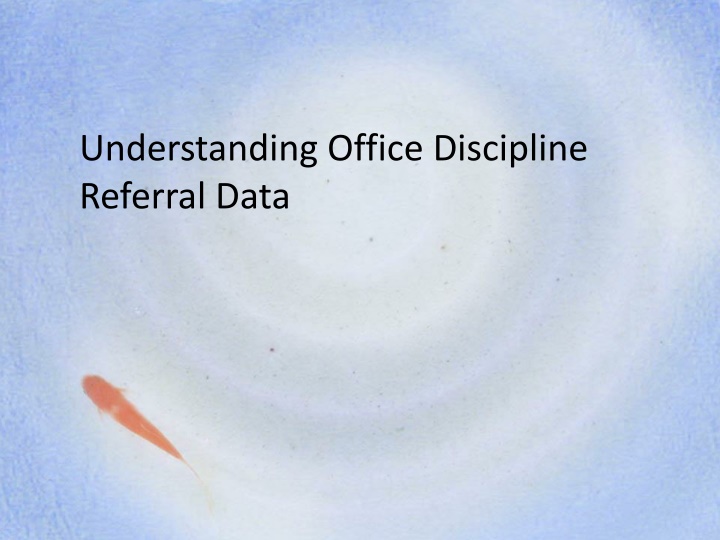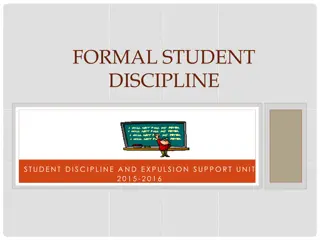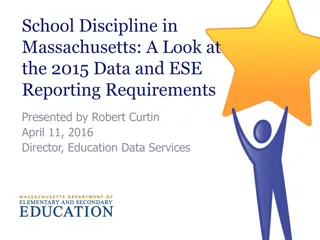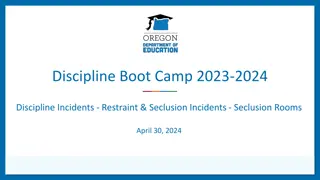Office Discipline Referral Data Analysis
This document provides insights into the collection, analysis, and utilization of office discipline referral data in a structured manner. It outlines steps for identifying sources of information, organizing data, conducting continual analysis, and building action plans based on data trends. The content includes visuals on data collection sources, referral rates, behavior trends, location comparisons, and incident time codes at Harlan Elementary School.
Download Presentation

Please find below an Image/Link to download the presentation.
The content on the website is provided AS IS for your information and personal use only. It may not be sold, licensed, or shared on other websites without obtaining consent from the author.If you encounter any issues during the download, it is possible that the publisher has removed the file from their server.
You are allowed to download the files provided on this website for personal or commercial use, subject to the condition that they are used lawfully. All files are the property of their respective owners.
The content on the website is provided AS IS for your information and personal use only. It may not be sold, licensed, or shared on other websites without obtaining consent from the author.
E N D
Presentation Transcript
Understanding Office Discipline Referral Data
Steps of Data Collection, Analysis, and Use 1. 2. 3. 4. Identify sources of information and data Summarize/Organize Data Continual Data Analysis Build action plan based on data trends Sources Organize Analysis Action Plan
Sources The Big Five Average Referral/Day/Month # of Referrals by Behavior # of Referrals by Location # of Referrals by Time of Day # of Referrals by Student
Sources The Big Five Average Referral/Day/Month # of Referrals by Behavior # of Referrals by Location # of Referrals by Time of Day # of Referrals by Student
Average Referral Rate per Month Harlan Elementary School Behavior Referrals/Day/Month Organize Behavior Referrals/Day/Month 9 8 7 2000-2001 2001-2002 2002-2003 2003-2004 2004-2005 2005-2006 6 5 4 3 2 1 0 sept jan june may nov dec april feb march oct Months
Organize Comparison by Location 250 200 150 2002-2003 2003-2004 100 50 0 Gym Ot her Locat i on Li brary Hal l / Breeze way Caf et eri a Pl ayground Cl assroom
Organize Incident Time Code 1 2 3 4 5 6 7 8 Count for Incident Code Time 23 16 14 11 16 17 21 49 Total: 167 Time Intervals: 0 = Time missing 5 = 11:00 - 11:59 10 = 16:00 - 16:59 15 = 21:00 - 21:59 1 = 07:00 - 07:59 6 = 12:00 - 12:59 11 = 17:00 - 17:59 16 = 22:00 - 22:59 2 = 08:00 - 08:59 7 = 13:00 - 13:59 12 = 18:00 - 18:59 17 = 23:00 - 23:59 3 = 09:00 - 09:59 8 = 14:00 - 14:59 13 = 19:00 - 19:59 4 = 10:00 - 10:59 9 = 15:00 - 15:59 14 = 20:00 - 20:59
Organize Referrals by Student Behavior Reporting Triangle 100% 4% 6+ Referrals 90% 2 - 5 Referrals 21% 0 - 1 Referrals 80% 70% Total Enrollment 327 60% 50% # of Students with 0-1 247 76% 40% 76% 30% # of Students with 2-4 68 21% 20% 10% # of Students with 6+ 12 4% 0%
Sources Other Referral Information # of referrals per Day of the Week # of Suspensions (In-School and Out-of-School) # of Referrals by Classroom # of Referrals by Staff # of Referrals compared to # of acknowledgments Others?
Organize Office Referrals by Day of Week 1994-1995 600 550 500 450 400 350 300 250 Mon Tue Day of Week Wed Thu Fri
Organize Suspensions Data 90 80 70 60 50 In School Suspensions Out of School Suspensions 40 30 20 10 0 Events Students Contributing
Organize Acknowledgements & Minor Incidences per Day per Month 40 35 30 # per Day 25 Acknowledgements Minors 20 15 10 5 0 Sep Oct Nov Dec Jan Feb Mar Apr May Jun Months
Why Collect Data Decision making Professional accountability Decisions made with data (information) are more likely to be (a) implemented, and (b) be effective You won t just be relying on a hunch to know if you are effective Adapted from Using Data for Decision-making Rob H. Horner, George Sugai, Teri Lewis-Palmer, & Anne W. Todd
Key Features of Data Systems That Work The data are accurate The data are easy to collect Data are used for decision-making The data must be available when decisions need to be made The people who collect the data must see the information used for decision-making Adapted from Using Data for Decision-making Rob H. Horner, George Sugai, Teri Lewis-Palmer, & Anne W. Todd
What Data to Collect for Decision-Making USE WHAT YOU HAVE Office Discipline Referrals/Detentions - Measure of overall environment Referrals are affected by: (a) student behavior (b) staff behavior (c) administrative context Suspensions/Expulsions Other Sources Adapted from Using Data for Decision-making Rob H. Horner, George Sugai, Teri Lewis-Palmer, & Anne W. Todd























